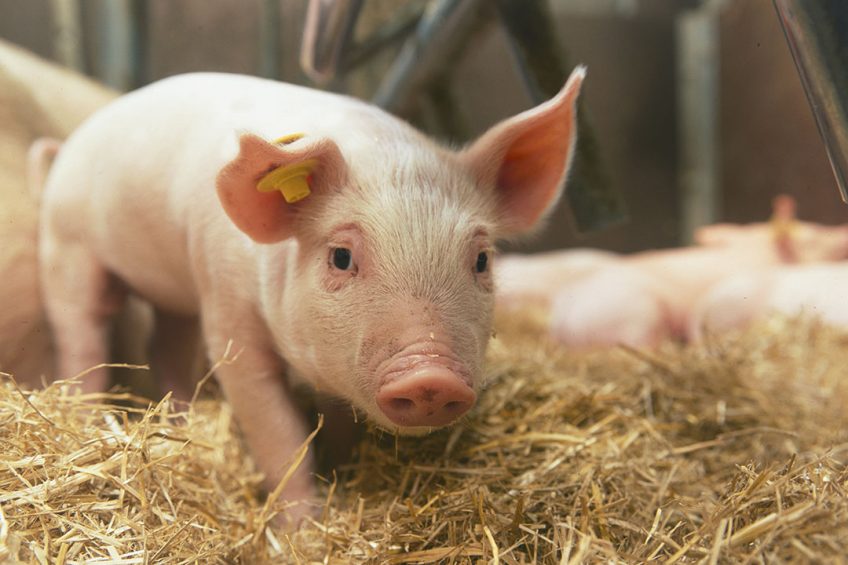Straw or no straw? That’s the question

Some have their pigs bedded in fresh straw whereas others don’t want to have any of it. Both are right, as there are some strong reasons to choose in favour of straw as well as strong reasons to be cautious with it. Which are advantages and disadvantages of straw and why is it important to know both?
Natural bedding material like straw and hay are only sparsely used in commercial pig production. If used, it is mainly for sows rather than for growers or finishers. When asking citizens unfamiliar with pig husbandry what they think pig farming looks like, they often draw pigs outdoors or indoors in a bed of straw. After all, that is what comes up in when you use Google images whilst searching for terms related to pigs. Whichever option is chosen, it is easy to agree that a pig in a fresh bed of straw looks nicer, and some would say happier, than a pig on a concrete floor. The reality might differ.
Obvious reasons to say ‘no’
Obvious reasons to not give any straw to pigs would be, most prominently, the costs and biosecurity risks. Prices for straw or hay are sometimes sky-high. Some studies find a better growth rate in pigs on straw but it is hard to say whether that weighs up against the costs. If it is available as a product of own land, then it might be more doable.
Biosecurity risks are many, with the current African Swine Fever (ASF) threat being just one of them. Wild animals, and their excreta, which were in the field may all end up in the product. Together with an unpredictable climate, it is difficult to control which bacteria, viruses and fungi might be brought onto the farm. Moreover, the isolating property of straw can worsen the conditions for pigs kept in hot and humid climates.
Want to learn more about ASF? Use this interactive health tool to find out more
Obvious reasons to say ‘yes’
Who does not struggle with tail biting pigs? If there is no tail biting going on, then it might be due to tail docking or straw. Keeping pigs with long undocked – and intact – tails in a conventional indoor system without straw is almost impossible. Other sacrifices would need to be made for that, such as extra space allowance. In that case, straw weighs up against the costs that would otherwise occur for keeping fewer pigs per m2, veterinary treatments, mortality, reduced growth performance and carcass devaluation.
Research has unanimously shown that straw improves the welfare of pigs. Despite all the research on different types of enrichment materials, long straw still best fulfils the requirements of good enrichment for pigs, which is that it is investigable, manipulable, chewable (including deformable and destructible), edible, and can be shared between multiple pigs, as was demonstrated in a recent study by Heleen van de Weerd and Sarah Ison, published in Animals in 2019. Good environmental enrichment is one of the key factors for pig welfare and is a necessity for a healthy behavioural development rather than a luxury.
Want to learn more about Mycotoxins? Use this interactive tool to find out more
A case of two extremes
A recent farm visit in Austria was the reason for highlighting the concerns, especially to people (including researchers) who promote the use of straw without further warning. The farm had a strong focus on animal welfare and the sows and pigs got some straw daily as light bedding on a partly slatted floor. Sows in farrowing pens had a hay rack and received twice a day hay, which they would eagerly chew on (unfortunately this also causes a lot of solid manure and thus more dirty farrowing pens). Pigs are not tail docked and there are commonly no problems with tail biting (pigs are kept till ten weeks of age). On an earlier visit the piglets were showing some signs of mycotoxin exposure, like tail necrosis and joint inflammations, but this didn’t seem too worrying. Then, some sows suddenly were found dead in the farrowing pen and some had to be euthanised. Upon autopsy a sow turned out to have internal bleeding due to stomach ulcers.
Mycotoxin risk
Straw and hay were tested as mycotoxins can also cause stomach ulcers (see also Table 1). The report showed that in the bought-in straw there was 6217 μg/kg of Deoxynivalenol and also tested ‘positive’ for zearalenone (60.6 μg/kg), 3-AcetylDeoxynivalenol (204 μg/kg), 15-AcetylDeoxynivalenol (314 μg/kg) and sterigmatocystin (10.2 μg/kg). Unfortunately the hay from own land also had 45.5 μg/kg of the mycotoxin T-2 and 12.7 μg/kg sterigmatocystin. Straw and hay was removed from the pigs. Now, only tested and approved straw and hay is given.
Table 1 – The effects of mycotoxins
| Mycotoxin | Related to… |
| Deoxynivalenol (vomitoxin) | Development of paraesophageal stomach ulcers |
| Zearalenone (F-2 mycotoxin) | Fertility problems and abortion, especially in sows |
| 3- and 15- AcetylDeoxynivalenol | Reduced feed intake and reduced body weight gain, oesophageal stomach lesions in pigs and lesions in the lungs, liver and kidneys |
| Sterigmatocystin | Similar effects to aflatoxin B, negatively affects the liver |
| T-2 (Trichothecene toxins) | Problems in gastro-intestinal tract, skin, kidney, liver, and immune systems. Related to neural, reproductive, immunological and hematological effects. Can be lethal in farm animals. Note that T-2 is also toxic when inhaled |
Note that many of the mycotoxins described in Table 1 are also toxic for humans and can even penetrate through the human skin or be inhaled. Therefore mycotoxins on farm are not only a risk for the animals but also for the people handling the raw material (straw, grains, feed stuffs etc.).
Try before you buy
What can be taken away from this is that it is good idea to be very cautious. Certainly in years when the weather conditions are favourable for the development of mycotoxins (warm and rainy) it is essential to test the product, of course best before buying it. If large quantities are bought that turn out to be full with mycotoxins then this brings considerable financial losses. So yes, the no-sayers are right to be very cautious with the risks of straw, even beyond mycotoxins, but when considering reducing tail biting, improving sow lying comfort or improving animal welfare and the farm image in general then straw can be, in the right climatic conditions, a very rewarding method.

Less risky alternatives
Of course there are alternatives as well for providing straw or hay, depending on the purpose that it has to serve. If straw is given to reduce tail biting in grow-finishing pigs then other preventive measures can be taken such as reducing stocking density, providing other suitable enrichment materials, and having a proper management protocol for the removal of biters or victims. If straw has the purpose of bedding for sows then sawdust, sand, mats or rice husks can be considered (although rice may also harbour some mycotoxins). As bedding for young piglets, sawdust, burlap sacks or shredded paper can be an alternative.











